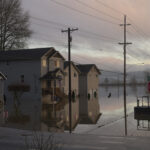Natural disasters can strike at any time, often without warning, and devastate cities, regions, states and countries.
Nature Unleashed, a new exhibit at the Indiana State Museum, aims to help Hoosiers understand why tornadoes, earthquakes, hurricanes, tsunamis and volcanic eruptions occur, and show how they can prepare in advance to have the best chance of survival no matter what the planet throws their way.
“Really, knowledge is power – the more you know about something, the more you understand what to do when it happens,” said Peggy Fisherkeller, curator of geology at the Indianapolis museum.
Tornadoes are the most common natural disaster in Indiana. The state sees, on average, 14 of its 25 annual tornadoes happen during the months of April, May and June.
But tornadoes can hit Indiana communities any month of the year.
It was an August tornado that damaged more than 1,000 buildings in Kokomo last summer. A March 2012 tornado destroyed Henryville High School in southern Indiana.
“This exhibit helps talk about tornadoes, why they occur, what we can do to protect ourselves, what we’re working to do to predict them and to make it safer for people,” Fisherkeller said.
It uses debris, including a twisted stop sign and destroyed school desks, recovered from a 2007 Greensburg, Kansas, tornado, along with large photos of that tornado’s path of destruction, to demonstrate the strength of the swirling winds.
Visitors also can experience what it’s like inside a tornado thanks to rare video of a 2004 Iowa twister passing over a camera that was planted directly in the storm’s path.
“It really shows how strong and how dangerous it is,” Fisherkeller said. “We’re hoping that people can really understand what the human cost is and how scientists are working to understand and predict future events.”
One natural disaster scientists have yet to devise a reliable prediction model for is earthquakes.
While most Americans believe earthquakes largely are a California phenomenon, in fact fault lines exist throughout Indiana and Illinois and sometimes move enough to get noticed on the surface.
Hoosiers also are potentially endangered by the New Madrid, Missouri, seismic zone that in 1811 and 1812 touched off three major earthquakes that were among the most powerful in American history.
While there were relatively few people in Indiana to feel them five years before statehood, a reoccurrence, now that 6.6 million people call Indiana home, could severely impact the state’s economy and way of life for months, or even years, to come.
“Scientists are divided on whether or not a `big one’ is going to occur soon. But it’s important to be aware that in 1811 and 1812 there was a massive earthquake from that region,” Fisherkeller said.
The earthquake portion of the exhibit uses models of different kinds of geological faults that visitors can manipulate with their hands to better understand why some earthquakes are more destructive than others.
Similar hands-on activities continue throughout Nature Unleashed, with volcanic lava to touch, buttons that cause virtual hurricanes to form and an opportunity to hear different sized earthquakes rumble.
Visitors also can view artifacts from well-known disasters, including a clarinet found in New Orleans after the city was hit by Hurricane Katrina in 2005, and jewelry encased in lava following the 79 A.D. eruption of Italy’s Mount Vesuvius, which destroyed Pompeii.
“It gives us a sense of the true power of nature,” Fisherkeller said.
Was this article valuable?
Here are more articles you may enjoy.

 Pacific Northwest Braces for Even More Flooding Rain This Week
Pacific Northwest Braces for Even More Flooding Rain This Week  NYT, Chicago Tribune Sue Perplexity AI as Copyright War Rages On
NYT, Chicago Tribune Sue Perplexity AI as Copyright War Rages On  Trump Sues BBC for $10 Billion Over Documentary Edit
Trump Sues BBC for $10 Billion Over Documentary Edit  Atmospheric River to Flood Pacific Northwest Through Week
Atmospheric River to Flood Pacific Northwest Through Week 